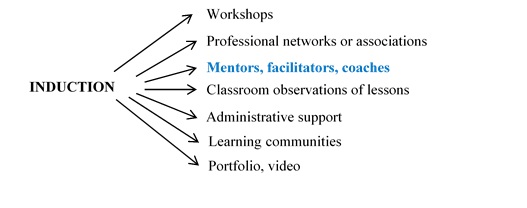Induction and mentoring are not ‘new', with substantive research available in the area. In most of these studies though, induction and mentoring are usually associated with teacher retention, particularly in countries like the United States where 40-50 per cent of teachers are reported to leave the profession in the first five years (Ingersoll, 2003).
The case is different in Australia, where the focus of induction and mentoring is placed squarely around quality teaching and the need to support our next generation of teachers in developing their knowledge, expertise and professional competency.
While the two terms are often linked, induction and mentoring are quite different in their focus and intention. Induction is a process whereas mentoring is one of a number of actions that can support the induction process (Figure 1).

Figure 1: Possible components of induction programs. (Source: adapted Wong, 2004).
Part of the confusion evident in this space is that the nature of induction and mentoring has evolved with time. For example, induction was conceived initially as a temporary bridge to support new teachers in their role while mentoring was about providing a ‘buddy' to help new teachers navigate the daily routines of a school or site.
Within Australia, the quality teaching lens raises the bar with induction becoming more encompassing of a ‘process for incorporating new teachers into collaborative professional learning communities' (Feiman-Nemser, 2012).
Hence, this becomes more long-term with an emphasis on enculturation and building teacher knowledge, skills and reflective practices as required of professionals. Similarly, mentoring involves the development of strong professional relationships that facilitate academic discussions and teacher planning while also challenging less experienced teachers in their professional thinking.
For teacher regulatory authorities across Australia, induction and mentoring are pivotal in nurturing and supporting teachers in moving from the Graduate to Proficient career stage of the Australian Professional Standards for Teachers (APST). This specific focus aligns with comprehensive induction and practice-focused mentoring as used by the Australian Institute for Teaching and School Leadership (AITSL, 2016).
To explore the nature of quality induction and mentoring practices in this space and develop cases of ‘good practice', the Teachers Registration Board of South Australia (TRBSA) conducted a research project in 2017. Over the course of several months interviews were undertaken with:
- teachers who had recently transitioned to (full) Registration (n = 32);
- mentors who had worked with these teachers through the process (n = 30);
- evaluators who evaluated teachers' evidence ensuring attainment of the Proficient standards (n = 7); and,
- key personnel from 13 stakeholders (e.g. all employers, teacher unions, and professional associations).
Teachers were selected for focus group interviews using a number of criteria identified in the research literature as being indicative of quality induction and mentoring. In synthesising these findings a number of individual case studies were developed to represent the diversity of teachers registered in South Australia. Amanda's case is one such example.
Case study context
Amanda is a primary teacher who was able to transition to (full) Registration having been employed as a temporary relief teacher (TRT), on short-term and one long-term contract. At the time of conducting the interview, Amanda had been teaching for six years and had still not gained full-time, permanent employment. It took Amanda five years to move from Provisional to (full) Registration.
Professional journey
Amanda worked in a number of primary schools and within each received basic orientation by the Deputy Principal who introduced all the school routines and expectations. However, it was not until she became a regular in one or two schools that Amanda really benefited from ongoing induction as teachers in the same year level included her in their professional conversations.
Working with a team of primary teachers all teaching the same year level of students provided excellent induction into the world of programing, planning for teaching and thinking about assessment. It was this collaborative team approach that gave Amanda the mentoring required as a Provisionally-registered teacher. Further support for Amanda came with the allocation of a formal mentor: ‘We planned units of work together, discussed how the class would be run, and both brought our previous teaching experiences to our classroom. She has been there to answer my questions and offer advice when I needed her opinion, especially with things like report writing.'
There are two key points to note about Amanda. The first point is that she made a conscious decision to limit the number of schools in which she worked so as to build and establish sustained professional relationships. The second point is that it was by undertaking short-term contracts and acting as a TRT in these schools that she was able to gain a one-year contract in one of these schools.
Moving to (full) Registration
The opportunity for Amanda to move from Provisional to (full) Registration came about because Amanda deliberately sought employment in the same schools. This is potentially a risky strategy but paid off for Amanda because it enabled her to build a relationship with a potential evaluator – ‘a teacher who knows my work'. In Amanda's case, it was the evaluator who actually suggested that she was ready to move to (full) Registration.
As part of the process for transitioning, Amanda was observed teaching and interacting with students on a number of occasions. However, this was not done especially as part of the process because the evaluator had been observing Amanda's teaching from the outset. Informal meetings occurred between Amanda and her evaluator, with evidence demonstrative of the Proficient level of the APST shared along with feedback.
While most of the standards were accessible, Amanda found that standards 5 (student assessment) and 7 (relationships with parents) were particularly challenging. Without the one-year contract, Amanda would have found it extremely difficult to accrue the experience required to demonstrate the Proficient level for these two standards.
The experiences shared by Amanda are common for many Provisionally-registered teachers in South Australia who need to become established in schools as relief teachers before they are able to accrue longer-term contracts, which are needed to transition to (full) Registration. However, in building relationships in schools it is the Provisionally-registered teacher who must take the initiative: ‘You need to build as many strong relationships as possible. Even if in the school as a TRT, make sure you say ‘hello' and get to know other teachers from the outset so that they become familiar with you and get used to seeing you around the school.'
Evidence of quality induction and mentoring
This case study exemplifies a number of characteristics of quality comprehensive induction and practice-focused mentoring, including:
- orientation – e.g. usual onboarding procedures and processes regarding school policy and expectations;
- wellbeing – e.g. colleagues prepared to work with her ensuring she was not working alone and isolated;
- professional practices – e.g. leadership contact and commitment, opportunities to study teaching with common planning time and the chance to share and reflect on teaching practices, standards-based evaluation of teaching; and,
- professional identity – e.g. access to a network of teachers, inclusion as part of the team within the school.
Pivotal to this particular case study is that even though Amanda was employed in a contractual capacity and as a TRT she was supported by the small group of schools she worked with to move to (full) Registration. Being able to work alongside experienced teachers, Amanda was able to build her professional knowledge and a deep understanding of ways of enhancing student learning.
Findings of the research project and seven case studies are detailed in the report Fostering our next generation of teachers: Induction and mentoring, available to download through the TRBSA website.
References
Australian Institute for Teaching and School Leadership. (2016). Graduate to proficient: Australian guideline for teacher induction into the profession. Retrieved from, https://www.aitsl.edu.au/tools-resources/resource/graduate-to-proficient-australian-guidelines-for-teacher-induction-into-the-profession
Feiman-Nemser, S. (2012). Beyond solo teaching. Educational Leadership, 69(8), 10-16.
Ingersoll, R. M. (2003). Is there really a teacher shortage? Philadelphia, PA: Consortium for Policy Research in Education, University of Pennsylvania. Retrieved from, http://www.gse.upenn.edu/pdf/rmi/Shortage-RMI-09-2003.pdf
Wong, H. K. (2004). Induction programs that keep new teachers teaching and improving. National Association of Secondary School Principals Bulletin, 88. Retrieved from, http://newteacher.com/pdf/Bulletin0304Wong.pdf
As a school leader, how are you supporting teachers who are newly qualified? What are the training needs of staff members chosen to mentor others?
As a beginning teacher, what are some of the things you need particular help with? Do you have a mentor that can assist you in these areas? Where do you go for professional support and guidance?



